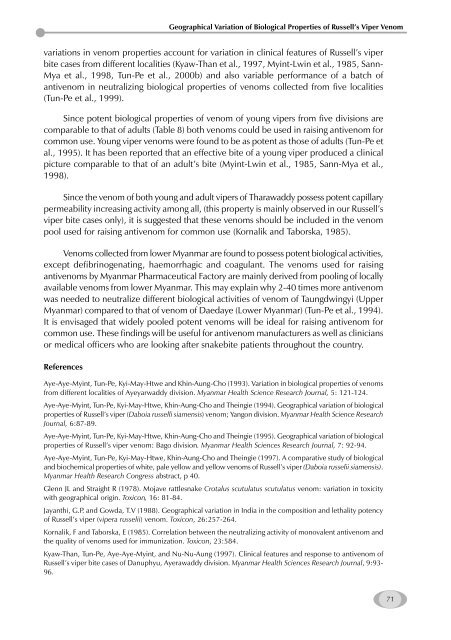Management of Snakebite and Research Management of Snakebite ...
Management of Snakebite and Research Management of Snakebite ...
Management of Snakebite and Research Management of Snakebite ...
You also want an ePaper? Increase the reach of your titles
YUMPU automatically turns print PDFs into web optimized ePapers that Google loves.
variations in venom properties account for variation in clinical features <strong>of</strong> Russell’s viper<br />
bite cases from different localities (Kyaw-Than et al., 1997, Myint-Lwin et al., 1985, Sann-<br />
Mya et al., 1998, Tun-Pe et al., 2000b) <strong>and</strong> also variable performance <strong>of</strong> a batch <strong>of</strong><br />
antivenom in neutralizing biological properties <strong>of</strong> venoms collected from five localities<br />
(Tun-Pe et al., 1999).<br />
Since potent biological properties <strong>of</strong> venom <strong>of</strong> young vipers from five divisions are<br />
comparable to that <strong>of</strong> adults (Table 8) both venoms could be used in raising antivenom for<br />
common use. Young viper venoms were found to be as potent as those <strong>of</strong> adults (Tun-Pe et<br />
al., 1995). It has been reported that an effective bite <strong>of</strong> a young viper produced a clinical<br />
picture comparable to that <strong>of</strong> an adult’s bite (Myint-Lwin et al., 1985, Sann-Mya et al.,<br />
1998).<br />
Since the venom <strong>of</strong> both young <strong>and</strong> adult vipers <strong>of</strong> Tharawaddy possess potent capillary<br />
permeability increasing activity among all, (this property is mainly observed in our Russell’s<br />
viper bite cases only), it is suggested that these venoms should be included in the venom<br />
pool used for raising antivenom for common use (Kornalik <strong>and</strong> Taborska, 1985).<br />
Venoms collected from lower Myanmar are found to possess potent biological activities,<br />
except defibrinogenating, haemorrhagic <strong>and</strong> coagulant. The venoms used for raising<br />
antivenoms by Myanmar Pharmaceutical Factory are mainly derived from pooling <strong>of</strong> locally<br />
available venoms from lower Myanmar. This may explain why 2-40 times more antivenom<br />
was needed to neutralize different biological activities <strong>of</strong> venom <strong>of</strong> Taungdwingyi (Upper<br />
Myanmar) compared to that <strong>of</strong> venom <strong>of</strong> Daedaye (Lower Myanmar) (Tun-Pe et al., 1994).<br />
It is envisaged that widely pooled potent venoms will be ideal for raising antivenom for<br />
common use. These findings will be useful for antivenom manufacturers as well as clinicians<br />
or medical <strong>of</strong>ficers who are looking after snakebite patients throughout the country.<br />
References<br />
Geographical Variation <strong>of</strong> Biological Properties <strong>of</strong> Russell’s Viper Venom<br />
Aye-Aye-Myint, Tun-Pe, Kyi-May-Htwe <strong>and</strong> Khin-Aung-Cho (1993). Variation in biological properties <strong>of</strong> venoms<br />
from different localities <strong>of</strong> Ayeyarwaddy division. Myanmar Health Science <strong>Research</strong> Journal, 5: 121-124.<br />
Aye-Aye-Myint, Tun-Pe, Kyi-May-Htwe, Khin-Aung-Cho <strong>and</strong> Theingie (1994). Geographical variation <strong>of</strong> biological<br />
properties <strong>of</strong> Russell’s viper (Daboia russelli siamensis) venom; Yangon division. Myanmar Health Science <strong>Research</strong><br />
Journal, 6:87-89.<br />
Aye-Aye-Myint, Tun-Pe, Kyi-May-Htwe, Khin-Aung-Cho <strong>and</strong> Theingie (1995). Geographical variation <strong>of</strong> biological<br />
properties <strong>of</strong> Russell’s viper venom: Bago division. Myanmar Health Sciences <strong>Research</strong> Journal, 7: 92-94.<br />
Aye-Aye-Myint, Tun-Pe, Kyi-May-Htwe, Khin-Aung-Cho <strong>and</strong> Theingie (1997). A comparative study <strong>of</strong> biological<br />
<strong>and</strong> biochemical properties <strong>of</strong> white, pale yellow <strong>and</strong> yellow venoms <strong>of</strong> Russell’s viper (Daboia russelii siamensis).<br />
Myanmar Health <strong>Research</strong> Congress abstract, p 40.<br />
Glenn JL <strong>and</strong> Straight R (1978). Mojave rattlesnake Crotalus scutulatus scutulatus venom: variation in toxicity<br />
with geographical origin. Toxicon, 16: 81-84.<br />
Jayanthi, G.P. <strong>and</strong> Gowda, T.V (1988). Geographical variation in India in the composition <strong>and</strong> lethality potency<br />
<strong>of</strong> Russell’s viper (vipera russelii) venom. Toxicon, 26:257-264.<br />
Kornalik, F <strong>and</strong> Taborska, E (1985). Correlation between the neutralizing activity <strong>of</strong> monovalent antivenom <strong>and</strong><br />
the quality <strong>of</strong> venoms used for immunization. Toxicon, 23:584.<br />
Kyaw-Than, Tun-Pe, Aye-Aye-Myint, <strong>and</strong> Nu-Nu-Aung (1997). Clinical features <strong>and</strong> response to antivenom <strong>of</strong><br />
Russell’s viper bite cases <strong>of</strong> Danuphyu, Ayerawaddy division. Myanmar Health Sciences <strong>Research</strong> Journal, 9:93-<br />
96.<br />
71









